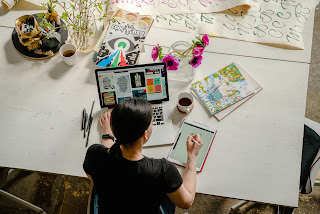Graphic design is a visual art that blends creativity and technology to communicate a message or tell a story.
Whether a logo, a website, a brochure, or a poster, graphic design can evoke emotions, inspire action, and leave a lasting impression.\
This blog will delve into graphic design and explore its facets, from design basics to tips and tricks for success.
The Fundamentals of Graphic Design
Graphic design is creating visual content to communicate a message or idea. It involves using typography, imagery, and color to create aesthetically pleasing and effective designs.
A graphic designer creates designs that accurately reflect the client's vision and goals while considering the target audience and the intended message
.
The Significance of Typography
Typography is a crucial element of graphic design, providing the foundation for visual composition. A graphic designer must select and arrange typefaces, font sizes, and other elements to create a harmonious and legible composition.
The typography must be easy to read, convey the intended tone, and support the overall design.
The Importance of Imagery
Images play a vital role in graphic design, as they can evoke emotions, create visual interest, and help tell a story. When selecting images for a design, the graphic designer must consider factors such as resolution, size, and orientation.
They must also be mindful of copyright and trademark laws when using images in their designs.
The Power of Color
Color is a powerful tool in graphic design, as it can convey mood, create visual interest, and make a design stand out. A good understanding of color theory is essential for graphic designers, as it allows them to choose the right colors for a design and create a harmonious color palette.
Tips for Successful Graphic Design
Know your audience: Understanding your target audience is key to successful graphic design. Consider its interests, pain points, and values when creating designs, and ensure they resonate with them.
Please keep it simple: Simple designs are often the most effective, as cluttered or complicated designs can confuse and distract the audience, making it difficult for them to understand the message.
Stay current: Technology and design trends are constantly evolving, so it's important to stay up-to-date with the latest design tools and techniques. It will help you create fresh and relevant designs.
Experiment: Don't be afraid to experiment with different design elements and techniques. Trying new things will help you grow as a designer and create unique and memorable designs.
Collaborate: Collaborating with other designers or clients can lead to better designs and new perspectives. It can also help you build your professional network.
In conclusion, graphic design is a dynamic and exciting field that combines creativity, technology, and communication. By understanding the basics of typography, imagery, and color and following the tips for success, you can create beautiful, effective, and memorable designs. So let your creativity soar and embark on your graphic design journey today!




Learn the essentials of graphic design and motion graphics in this comphrehensive course.Gain Practical skills in visual storytelling,animation,and digital design to enhance your creative career and professional portfolio.
ReplyDelete